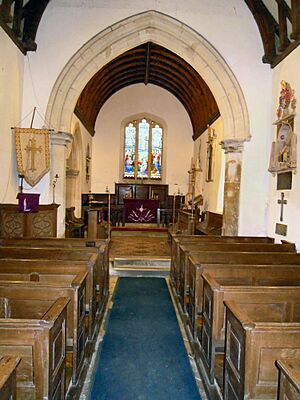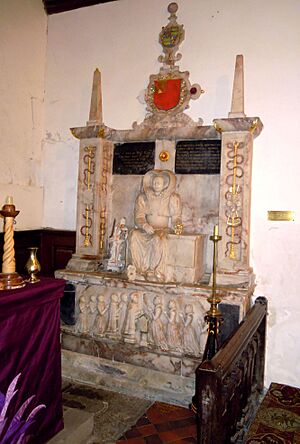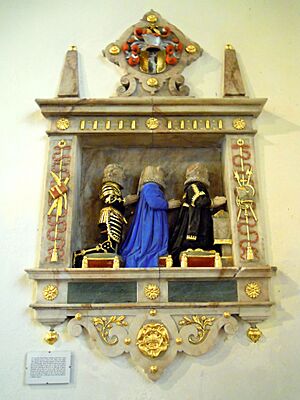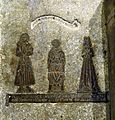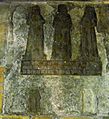Church of All Saints, Radwell facts for kids
Quick facts for kids Church of All Saints |
|
|---|---|
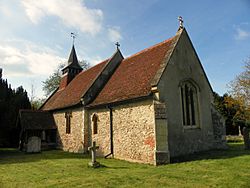
Church of All Saints in Radwell in Hertfordshire
|
|
| 52°00′27″N 0°12′22″W / 52.00747°N 0.20602°W | |
| Location | Radwell, Hertfordshire |
| Country | England |
| Denomination | Anglican |
| History | |
| Status | Church |
| Architecture | |
| Functional status | Active |
| Heritage designation | Grade II* |
| Designated | 1968 |
| Years built | 14th-century (current building) |
| Specifications | |
| Nave width | 16 feet 6 inches (5.03 m) |
| Materials | Flint, clunch |
| Bells | 2 |
| Administration | |
| Diocese | St Albans |
The Church of All Saints is a historic church located in Radwell, a village in Hertfordshire, England. It belongs to the Anglican faith and is part of the Diocese of St Albans. This church is very special, so it's protected as a Grade II* building. It received this important status in 1968.
Contents
Exploring the Church's Design
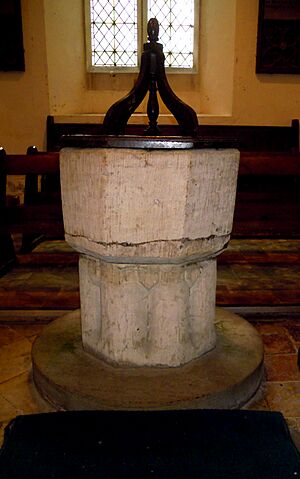
People believe there has been a church here since at least 1215. The first known church leader, called a rector, was Baldricus in 1218. That very old church was likely made mostly of wood. None of that first building remains today.
The current All Saints Church is a small parish church. It was built in the mid-14th century, around the 1300s. Its style is called Perpendicular Gothic, which means it has tall, thin windows and strong vertical lines. The church was repaired and updated a lot in the 1800s.
Parts of the Church Building
The church has several main parts. These include the chancel, which is the area around the altar. There's also a north vestry, a nave, and a south porch. The nave is the main part where people sit during services.
The church is built from flint and a soft stone called clunch. The chancel arch, window openings, and walls of the nave and chancel are from the mid-14th century. The large east window, which has three sections, is from about 1500. It has beautiful glass added in 1885.
The nave was repaired in 1875, and that's when the wooden pews were put in. The chancel was repaired in 1882. At that time, the vestry and south porch were added. The nave is quite short and doesn't have side aisles. It has only one window on its north and south walls.
Above the west end of the nave, you can see a small bell-cot. This is a small structure that holds the church bells. It has a little copper spire on top. A pointed arch separates the west end, which suggests the builders might have planned to add a tall tower later.
The chancel arch is from about 1340. It shows signs that a rood screen used to be there. A rood screen was a wooden or stone screen that separated the chancel from the nave. It was probably removed centuries ago.
Inside the Church
The church has a large baptismal font that is very old, from the 14th or 15th century. A baptismal font is a basin used for baptisms, a Christian ceremony. This font has shields carved into its base. The communion rails, which are fences around the altar, are from the 17th century.
The wooden pulpit was given to remember Frances Temple Proctor, who died in 1889, and her son Charles, who died in 1906. A pulpit is a raised stand where the preacher gives sermons.
Historic Monuments
Inside the church, you can find several interesting monuments. On the south wall of the chancel, there is a special tomb with a statue of Mary Plomer. She died in 1605 when she was 30 years old, after having her 11th child.
Her statue shows her sitting and holding a "chrisom child." This means the baby died within a month of being baptized. The baby was wrapped in a special cloth called a chrisom-cloth. This cloth was worn for a month after baptism to protect the holy oil used in the ceremony. This monument is a great example of Elizabethan art.
Next to Mary Plomer, there is a smaller figure of Father Time. The whole tomb is surrounded by decorated pillars. Below the statue, there is a panel showing her other ten children kneeling. Six are sons and four are daughters. Two of her sons are shown slightly set back, meaning they had died before her.
On the same wall, there is a monument for Ann Plomer, who died in 1625. On the north wall of the chancel, you can see a monument with small kneeling figures of John Parker, who died in 1595, along with his wife and son.
There are also several monumental brasses set into the floor of the chancel. These are engraved brass plates that act as memorials. One is for Elizabeth Parker, who died in 1602. Another is for William Wheteaker, who died in 1487, with his wife and son. In the nave, there is a brass for John Bele, who died in 1516, and his two wives and children.
Above the tower arch, you can see the stone-carved royal arms of King George IV, dated 1825. These are symbols of the British royal family.
In the churchyard outside, there is a memorial for Private E.G. Stockham, who died in 1919. This memorial is looked after by the Commonwealth War Graves Commission.
Church Bells
The Church of All Saints has two bells. Both are quite small. The first bell is very old and was likely made in the 14th century. The second bell is not as old and was probably remade in the 17th century.
Gallery
-
Royal Arms of George IV


